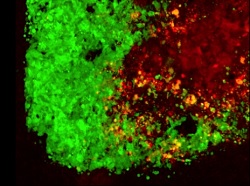 |
| Herpesvirus-loaded stem cells (red) infecting a glioblastoma brain tumor (green)--Courtesy of Harvard Stem Cell Institute |
Glioblastoma multiforme, the most common and one of the most aggressive forms of brain cancer, is for many reasons a notoriously difficult tumor to treat. Now, researchers from the Harvard Stem Cell Institute at Massachusetts General Hospital have developed a novel method of dealing with the disease: They're infecting the tumor with herpesvirus, shuttled into the brain in stem cells.
The team of scientists used bone marrow stem cells as delivery vehicles for herpesvirus, loaded into a gel and injected into the brains of mice. The bone marrow stem cells make a promising delivery vehicle because they don't cause much of an immune response, according to a report from Harvard.
In preclinical studies, herpesvirus has been shown to naturally infect dividing brain cells, although that particular therapy didn't work as well in human patients. That's where the gel comes in, keeping the stem cells alive for a longer time, thus preventing the virus from exiting the brain with the cerebrospinal fluid.
"We know that 70-75% of glioblastoma patients undergo surgery for tumor debulking, and we have previously shown that MSCs [mesenchymal stem cells] encapsulated in biocompatible gels can be used as therapeutic agents in a mouse model that mimics this debulking," lead author Khalid Shah said in a statement. "So, we loaded MSCs with oncolytic herpesvirus and encapsulated these cells in biocompatible gels and applied the gels directly onto the adjacent tissue after debulking. We then compared the efficacy of virus-loaded, encapsulated MSCs versus direct injection of the virus into the cavity of the debulked tumors."
Also loaded into the virus was the tumor-killing agent TRAIL, which led to higher survival of the mice in combination with the new treatment. The team published the study in the Journal of the National Cancer Institute.
- here's the Harvard Stem Cell Institute report
- and here's the abstract